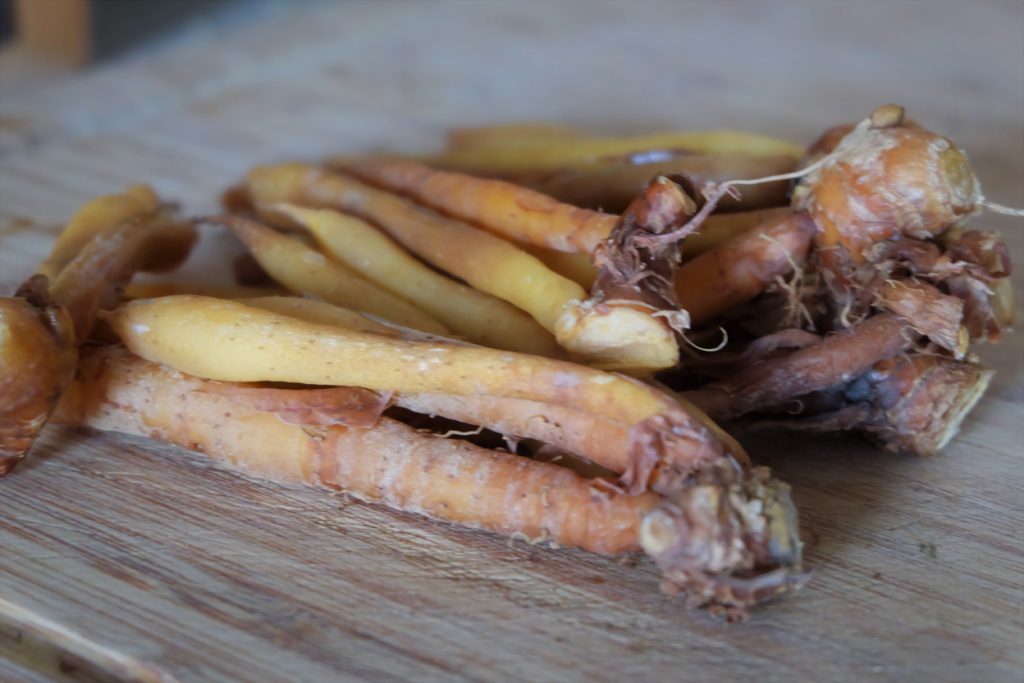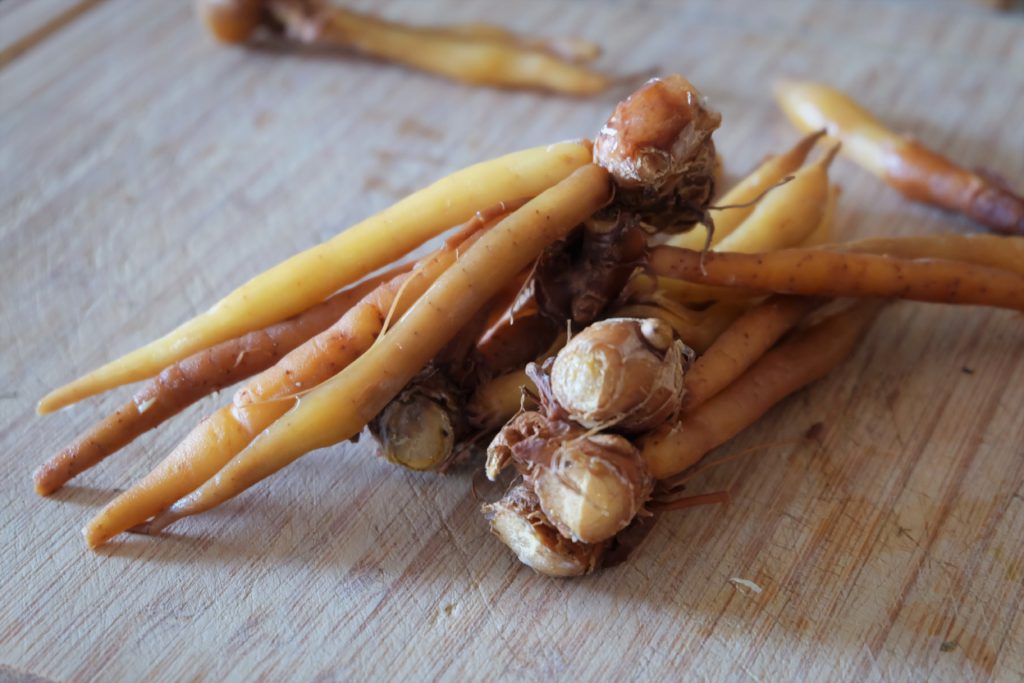- Latin: Boesenbergia rotunda
- English: Fingerroot, Galingale, Tumicuni
- Cambodian: K’cheay ខ្ជាយ
- Thai: Krachai กระชาย
- Indonesian: Temu Kunci
- Vietnamese: Ngải Bún, Nga Truật
- Chinese: Aochunjiang 凹脣薑
- Dutch: Temoe Koentjie
What is Fingerroot?
Fingerroot, Boesenbergia rotunda, belongs to the ginger family called Zingiberaceae. It is thus in the same family as the ginger, galangal and turmeric. Spread throughout Southeast Asia, it is used both as traditional medicine as well as a very common ingredient in the local cuisines.
Ever since it has been known to the outside world, researchers have found the fingerroot to possess incredible medicinal properties. It is anti-allergic, antibacterial, anticancer, anti-inflammatory, antioxidant, and antiulcer. Not only that, the fingerroot promotes wound healing. It is also known throughout the region as an effective aphrodisiac for men.
In terms of taste and smell, the fingerroot is not as pungent or hot as its cousins like the ginger or galangal. It has a delicate taste that really enhances seafood dishes.
Let’s explore these medicinal and culinary uses of the fingerroot!

Fingerroot fights E Coli
As you may know, E Coli (Escherichia Coli) are foodborne bacteria that may make one fall very ill and can sometimes be deadly. Most strains of E Coli do not harm us, and they are very much part of our gut environment. But there are a few strains of E Coli that create toxins, which bring about intestinal infections.
Because E Coli is foodborne, which can be on certain types of vegetables or meat, it is very difficult to contain an outbreak unless you can very quickly find the source.
While most people recover within a week, E Coli can be life-threatening to babies and people with compromised immunity. In many cases, E Coli have led to urinary tract infections, pneumonia, or even meningitis.
In a hot and wet tropical climate like that in Southeast Asia, it is a perfect environment for a pathogen like E Coli to thrive. But like most things in nature, there is always a counteracting force. It is the fingerroot.
Across the Malay Archipelago, the fingerroot has long been used to fight such infections. Fortunately, now it has been proven by science that fingerroot has specific antibacterial properties that counteract E Coli.
No wonder, fingerroot has always been used in copious amount in Southeast Asian cuisine.

Fingerroot makes your testicles heavier
Fingerroot has long been used as an aphrodisiac in Southeast Asia. Supposedly, it gives men a heightened libido, stronger erections, and improves the quality of your sperm.
While this may seem like an exaggeration, scientists have found that the fingerroot may really have uses in male fertility treatment.
Various Zingiberaceae roots were given to male rats over two and four weeks. In general, all Zingiberaceae aphrodisiac properties, and the researchers looked for changes in increase in sexual activities (libido), volume of semen, motility and number of sperm, percentage of life and abnormality of sperm.
The experiment found that the fingerroot scored better than its family members by increasing the quantity and quality of sperm. It was thought that the antioxidant activity of Boesenbergia rotunda might be the advantage that protects against testicular tissue damage and enhances the sperm quality.
In another experiment, male rats were grouped into four, three of which given fingerroot in increasing amounts while the fourth was a control group. All three groups saw an increase in sexual activities and “all doses of B. rotunda extract significantly increased the relative testicular weight and the diameter of the seminiferous tubules.” This means that fingerroot gave the rats better sperm and bigger balls.
I guess that’s good news for us men!

How is the fingerroot used in Southeast Asian cooking?
In Indonesia, the fingerroot is mostly used in Javanese and Balinese cuisines. It is added everywhere, in sauces, soups, pastes. Most remarkable of all, it is used in everyday medicinal concoctions called “jamu“. Jamu uses indigenous flora such as roots, flowers, leaves and seeds. The fingerroot is widely used in jamu due to its anti-bacterial properties. Jamu recipes combine different ingredients for different ailments, and add rice as a thickener. Once cooked and filtered, jamu is served as a drink to an ill person or for anyone who wants to avoid falling ill.
In Thai cuisine, the fingerroot is often mixed with fish or other seafood dishes. Kaeng tai pla แกงไตปลา, is a fish curry from the Phatthalung Province, that uses the fingerroot. Kanom Jeen Namya ขนมจีนนำ้ยา is an aromatic rice noodles dish that cannot do without the fingeroot. Pad Cha Talay ผัดฉ่าทะเล is a stir-fried prawn dish where the fingerroot is the secret ingredient which makes all the difference.
With all the amazing medicinal properties of the fingerroot, and its unique subtle taste, it is time you use the fingerroot in your cooking!
